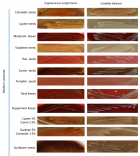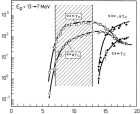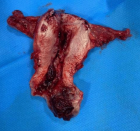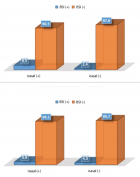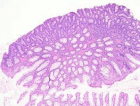Abstract
Research Article
Depression and anxiety in patients with suspected renal artery stenosis
Ludvig Hallberg*, Anders Gottsater, Anders Isaksson and Asa Westrin
Published: 06 September, 2021 | Volume 5 - Issue 1 | Pages: 009-015
Objective: To investigate the occurrence of depressive and anxiety disorders in patients remitted for endovascular treatment of renal artery stenosis (RAS), and whether symptoms of depression and anxiety can be reduced after the treatment of RAS with percutaneous transluminal renal angioplasty (PTRA).
Methods Patients: Selected for renal angiography with pressure measurement in the renal arteries due to suspected RAS were invited to participate in the study. 37 patients agreed to answer a questionnaire. Eighteen patients also agreed to a clinical psychiatric examination including the International Neuropsychiatric Interview (M.I.N.I. 6.0) to be diagnosed according to the DSM-IV.
Results: Twenty-one of the 37 patients completing the questionnaire were found to have a pressure gradient of ≥ 10 mmHg at angiography, indicating significant stenosis. Ten of the 18 examined patients met the criteria for current DSM-IV anxiety diagnosis and two patients had a current depression. Three of the 18 examined patients had previously made a suicide attempt.
Conclusion: The results of this study suggest that patients with suspected RAS have a high psychiatric comorbidity, as 56% of the patients undergoing psychiatric examination met the DSM-IV criteria for a current anxiety disorder.
Read Full Article HTML DOI: 10.29328/journal.ida.1001026 Cite this Article Read Full Article PDF
References
- Kessler RC, Berglund P, Demler O, Jin R, Koretz KR, et al. The epidemiology of major depressive disorder: results from the National Comorbidity Survey Replication (NCS-R). 2003; 289: 3095-3105. PubMed: https://pubmed.ncbi.nlm.nih.gov/12813115/
- Kessler RC, Berglund P, Demler O, Jin R, Merikangas KR, et al. Lifetime prevalence and age-of-onset distributions of DSM-IV disorders in the National Comorbidity Survey Replication. Arch Gen Psychiatry. 2005; 62: 593-602. PubMed: https://pubmed.ncbi.nlm.nih.gov/15939837/
- Rorsman BO. Hagnell, J. Lanke and L. Ojesjo. Incidence of anxiety in the Lundby Study: changes over time during a quarter of a century. Neuropsychobiology. 1987; 18: 13-20. PubMed: https://pubmed.ncbi.nlm.nih.gov/3444521/
- Mulinari S. Monoamine theories of depression: historical impact on biomedical research. J Hist Neurosci. 2012; 21: 366-392. PubMed: https://pubmed.ncbi.nlm.nih.gov/22947380/
- Bao AM, Meynen G, Swaab DF. The stress system in depression and neurodegeneration: focus on the human hypothalamus. Brain Res Rev. 2008; 57: 531-553. PubMed: https://pubmed.ncbi.nlm.nih.gov/17524488/
- Dantzer RJ. O'Connor C, Freund GG, Johnson RW, Kelley KW. From inflammation to sickness and depression: when the immune system subjugates the brain. Nat Rev Neurosci. 2008; 9: 46-56. PubMed: https://pubmed.ncbi.nlm.nih.gov/18073775/
- Kunzel HE. Psychopathological symptoms in patients with primary hyperaldosteronism--possible pathways. Horm Metab Res. 2012; 44: 202-207. PubMed: https://pubmed.ncbi.nlm.nih.gov/22351473/
- Ferrao FM, Lara LS, Lowe J. Renin-angiotensin system in the kidney: What is new? World J Nephrol. 2014; 3: 64-76. PubMed: https://pubmed.ncbi.nlm.nih.gov/25332897/
- DeForrest JM, Knappenberger RC, Antonaccio MJ, Ferrone RA, Creekmore JS. Angiotensin II is a necessary component for the development of hypertension in the two kidney, one clip rat. Am J Cardiol. 1982; 49: 1515-1517. PubMed: https://pubmed.ncbi.nlm.nih.gov/6280481/
- Basso N, Terragno NA. History about the discovery of the renin-angiotensin system. Hypertension. 2001; 38: 1246-1249. PubMed: https://pubmed.ncbi.nlm.nih.gov/11751697/
- Caps MT, Zierler RE, Polissar NL, Bergelin RO, Beach KW, et al. Risk of atrophy in kidneys with atherosclerotic renal artery stenosis. Kidney Int. 1998; 53: 735-742. PubMed: https://pubmed.ncbi.nlm.nih.gov/9507221/
- Gruntzig A, Kuhlmann U, Vetter W, Lutolf U, Meier B, et al. Treatment of renovascular hypertension with percutaneous transluminal dilatation of a renal-artery stenosis. Lancet 1. 1978; 1: 801-802. PubMed: https://pubmed.ncbi.nlm.nih.gov/85817/
- ASTRAL Investigators, Wheatley K, Ives N, Gray R, Kalra PA, et al. Revascularization versus medical therapy for renal-artery stenosis. N Engl J Med. 2009; 361: 1953-1962. PubMed: https://pubmed.ncbi.nlm.nih.gov/19907042/
- Cooper CJ, Murphy TP, Cutlip DE, Jamerson K, Henrich W, et al. Stenting and medical therapy for atherosclerotic renal-artery stenosis. N Engl J Med. 2014; 370: 13-22. PubMed: https://pubmed.ncbi.nlm.nih.gov/24245566/
- Gomez-Sanchez EP. Brain mineralocorticoid receptors in cognition and cardiovascular homeostasis. Steroids. 2014; 91: 20-31. PubMed: https://pubmed.ncbi.nlm.nih.gov/25173821/
- Klok MD, Alt SR, Irurzun Lafitte AJ, Turner JD, Lakke EA, et al. Decreased expression of mineralocorticoid receptor mRNA and its splice variants in postmortem brain regions of patients with major depressive disorder. J Psychiatr Res. 2011; 45: 871-878. PubMed: https://pubmed.ncbi.nlm.nih.gov/21195417/
- Hlavacova N, Jezova D. Chronic treatment with the mineralocorticoid hormone aldosterone results in increased anxiety-like behavior. Horm Behav. 2008; 54: 90-97. PubMed: https://pubmed.ncbi.nlm.nih.gov/18377905/
- Bay-Richter C, Hallberg L, Ventorp F, Janelidze S, Brundin L. Aldosterone synergizes with peripheral inflammation to induce brain IL-1beta expression and depressive-like effects. Cytokine. 2012; 60: 749-754. PubMed: https://pubmed.ncbi.nlm.nih.gov/22981168/
- Yau JL, Hibberd C, Noble J, Seckl JR. The effect of chronic fluoxetine treatment on brain corticosteroid receptor mRNA expression and spatial memory in young and aged rats. Brain Res Mol Brain Res. 2002; 106: 117-123. PubMed: https://pubmed.ncbi.nlm.nih.gov/12393271/
- Seckl JR, Fink G. Antidepressants increase glucocorticoid and mineralocorticoid receptor mRNA expression in rat hippocampus in vivo. Neuroendocrinology. 1992; 55: 621-626. PubMed: https://pubmed.ncbi.nlm.nih.gov/1321353/
- Yau JL, Noble J, Hibberd C, Seckl JR. Short-term administration of fluoxetine and venlafaxine decreases corticosteroid receptor mRNA expression in the rat hippocampus. Neurosci Lett. 2001; 306: 161-164. PubMed: https://pubmed.ncbi.nlm.nih.gov/11406320/
- Emanuele E, Geroldi D, Minoretti P, Coen E, Politi P. Increased plasma aldosterone in patients with clinical depression. Arch Med Res. 2005; 36: 544-548. PubMed: https://pubmed.ncbi.nlm.nih.gov/16099336/
- Sonino N, Fallo F, Fava GA. Psychological aspects of primary aldosteronism. Psychother Psychosom. 2006; 75: 327-330. PubMed: https://pubmed.ncbi.nlm.nih.gov/16899970/
- Sonino N, Tomba E, Genesia ML, Bertello C, Mulatero P, et al. Psychological assessment of primary aldosteronism: a controlled study. J Clin Endocrinol Metab. 2011; 96: E878-883. PubMed: https://pubmed.ncbi.nlm.nih.gov/21389142/
- Svanborg P, Asberg M. A new self-rating scale for depression and anxiety states based on the Comprehensive Psychopathological Rating Scale. Acta Psychiatr Scand. 1994; 89: 21-28. PubMed: https://pubmed.ncbi.nlm.nih.gov/8140903/
- Zigmond AS, Snaith RP. The hospital anxiety and depression scale. Acta Psychiatr Scand. 1983; 67: 361-370. PubMed: https://pubmed.ncbi.nlm.nih.gov/6880820/
- Asberg M, Montgomery SA, Perris C, Schalling D, Sedvall G. A comprehensive psychopathological rating scale. Acta Psychiatr Scand Suppl. 1978; 5-27. PubMed: https://pubmed.ncbi.nlm.nih.gov/277059/
- Montgomery SA, Asberg M. A new depression scale designed to be sensitive to change. Br J Psychiatry. 1979; 134: 382-389. PubMed: https://pubmed.ncbi.nlm.nih.gov/444788/
- Tyrer P, Owen RT, Cicchetti DV. The brief scale for anxiety: a subdivision of the comprehensive psychopathological rating scale. J Neurol Neurosurg Psychiatry. 1984; 47: 970-975. PubMed: https://pubmed.ncbi.nlm.nih.gov/6481391/
- Alhadad A, Mattiasson I, Ivancev K, Lindh M, Gottsater A, et al. Mean pressure gradient in renal artery stenosis (RAS) before and after percutaneous transluminal renal angioplasty (PTRA) regarding initial effect and long-term outcome. Useful or not? J Renovasc Dis. 2006; 7-13.
- Alhadad A, Guron G, Fortuna-Nowakowska E, Saeed A, Mattiasson I, et al. Renal angioplasty causes a rapid transient increase in inflammatory biomarkers, but reduced levels of interleukin-6 and endothelin-1 1 month after intervention. J Hypertens. 2007; 25: 1907-1914. PubMed: https://pubmed.ncbi.nlm.nih.gov/17762656/
- Alhadad A, Mattiasson I, Ivancev K, Lindblad B, Gottsater A. Predictors of long-term beneficial effects on blood pressure after percutaneous transluminal renal angioplasty in atherosclerotic renal artery stenosis. Int Angiol. 2009; 28: 106-112. PubMed: https://pubmed.ncbi.nlm.nih.gov/19367240/
- Alhadad A, Mattiasson I, Ivancev K, Lindh M, Gottsater A, et al. Does the pressure gradient in renal artery stenosis before and after percutaneous transluminal renal angioplasty predict initial and long-term outcome? J Renovasc Dis. 2006; 7-13.
- Sandstrom YK, Ljunggren G, Wandell P, Wahlstrom L, Carlsson AC. Psychiatric comorbidities in patients with hypertension - a study of registered diagnoses 2009-2013 in the total population in Stockholm County, Sweden. J Hypertens. 2016; 34: 414-420. PubMed: https://pubmed.ncbi.nlm.nih.gov/26766563/
- Mazza A, Ravenni R, Armigliato M, Rossetti C, Schiavon L, et al. Mood Disorders in Uncontrolled Hypertension Despite Multiple Anti-Hypertensive Medications: Searching for a Link. High Blood Press Cardiovasc Prev. 2016; 23: 41-46. PubMed: https://pubmed.ncbi.nlm.nih.gov/26729327/
- Nock MK, Borges G, Bromet EJ, Alonso J, Angermeyer M, et al. Cross-national prevalence and risk factors for suicidal ideation, plans and attempts. Br J Psychiatry. . 2008; 192: 98-105. PubMed: https://pubmed.ncbi.nlm.nih.gov/18245022/
- Kotliar C, Inserra F, Forcada P, Cavanagh E, Obregon S, et al. Are plasma renin activity and aldosterone levels useful as a screening test to differentiate between unilateral and bilateral renal artery stenosis in hypertensive patients? J Hypertens. 2010; 28: 594-601. PubMed: https://pubmed.ncbi.nlm.nih.gov/20104188/
- Ko DT, Hebert PR, Coffey CS, Sedrakyan A, Curtis JP, et al. Beta-blocker therapy and symptoms of depression, fatigue, and sexual dysfunction. JAMA. 2002; 288: 351-357. PubMed: https://pubmed.ncbi.nlm.nih.gov/12117400/
- Yu Y, Wei SG, Zhang ZH, Gomez-Sanchez E, Weiss RM, et al. Does aldosterone upregulate the brain renin-angiotensin system in rats with heart failure? Hypertension. 2008; 51: 727-733. PubMed: https://pubmed.ncbi.nlm.nih.gov/18227408/
- Hallberg L, Westrin A, Isaksson A, Janelidze S, Traskman-Bendz L, et al. Decreased aldosterone in the plasma of suicide attempters with major depressive disorder. Psychiatry Res. 2011; 187: 135-139. PubMed: https://pubmed.ncbi.nlm.nih.gov/20797799/
- Dowlati Y, Herrmann N, Swardfager W, Liu H, Sham L, et al. A meta-analysis of cytokines in major depression. Biol Psychiatry 67: 446-457. PubMed: https://pubmed.ncbi.nlm.nih.gov/20015486/
- Raison CL, Miller AH. Is depression an inflammatory disorder? Curr Psychiatry Rep. 2011; 13: 467-475. PubMed: https://pubmed.ncbi.nlm.nih.gov/21927805/
- Furtado M, Katzman MA. Neuroinflammatory pathways in anxiety, posttraumatic stress, and obsessive compulsive disorders. Psychiatry Res. 2015; 229: 37-48. PubMed: https://pubmed.ncbi.nlm.nih.gov/26296951/
- Brundin L, Erhardt S, Bryleva EY, Achtyes ED, Postolache TT. The role of inflammation in suicidal behaviour. Acta Psychiatr Scand. 2015; 132: 192-203. PubMed: https://pubmed.ncbi.nlm.nih.gov/26256862/
- Ventorp F, Gustafsson A, Traskman-Bendz L, Westrin A, Ljunggren L. Increased Soluble Urokinase-Type Plasminogen Activator Receptor (suPAR) Levels in Plasma of Suicide Attempters. PLoS One. 2015; 10: e0140052. PubMed: https://pubmed.ncbi.nlm.nih.gov/26451727/
Figures:
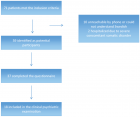
Figure 1
Similar Articles
-
Burnout and Related Factors in Caregivers of outpatients with SchizophreniaHatice Demirbas*,Erguvan Tugba Ozel Kizil. Burnout and Related Factors in Caregivers of outpatients with Schizophrenia. . 2017 doi: 10.29328/journal.hda.1001001; 1: 001-011
-
Multi-factorial Depressive Disorders Need Multi-dimensional InterventionsMustafa Melih Bilgi*. Multi-factorial Depressive Disorders Need Multi-dimensional Interventions. . 2017 doi: 10.29328/journal.hda.1001002; 1: 012-014
-
Anxiety and depression as an effect of birth order or being an only child: Results of an internet survey in Poland and GermanyJochen Hardt*,Lisa Weyer,Malgorzata Dragan,Wilfried Laubach. Anxiety and depression as an effect of birth order or being an only child: Results of an internet survey in Poland and Germany. . 2017 doi: 10.29328/journal.hda.1001003; 1: 015-022
-
Spiritual and religious Islamic perspectives of healing of posttraumatic stress disorderMevludin Hasanović*,Izet Pajević,Osman Sinanović. Spiritual and religious Islamic perspectives of healing of posttraumatic stress disorder. . 2017 doi: 10.29328/journal.hda.1001004; 1: 023-029
-
May we feed cancer?Maria Grazia Spurio*. May we feed cancer?. . 2018 doi: 10.29328/journal.ida.1001005; 2: 001-006
-
Vestibular-limbic relationships: Brain mappingPaolo Gamba*. Vestibular-limbic relationships: Brain mapping. . 2018 doi: 10.29328/journal.ida.1001006; 2: 007-013
-
Responding to Disasters: More than economic and infrastructure interventionsDavid Crompton OAM*,Ross Young,Jane Shakespeare-Finch,Beverley Raphael AM. Responding to Disasters: More than economic and infrastructure interventions. . 2018 doi: 10.29328/journal.ida.1001007; 2: 014-028
-
Mindset kinetics and some depression status: A new quantitative model under biochemical - toxicology approach?Luisetto M*,Ghulam Rasool Mashori,Behzad Nili-Ahmadabadi,Farhan Ahmad Khan,Kausar Rehman Khan. Mindset kinetics and some depression status: A new quantitative model under biochemical - toxicology approach?. . 2018 doi: 10.29328/journal.ida.1001008; 2: 029-039
-
Anti-anxiety effects in mice following acute administration of Ficus Thonningii (wild fig)Aduema W*,Akunneh-Wariso C,Ejiofo DC,Amah AK. Anti-anxiety effects in mice following acute administration of Ficus Thonningii (wild fig). . 2018 doi: 10.29328/journal.ida.1001009; 2: 040-047
-
Sleeplessness and healthSunitha V,Jeyastri Kurushev,Felicia Chitra,Manjubala Dash*. Sleeplessness and health. . 2019 doi: 10.29328/journal.ida.1001010; 3: 001-007
Recently Viewed
-
Navigating Neurodegenerative Disorders: A Comprehensive Review of Current and Emerging Therapies for Neurodegenerative DisordersShashikant Kharat*, Sanjana Mali*, Gayatri Korade, Rakhi Gaykar. Navigating Neurodegenerative Disorders: A Comprehensive Review of Current and Emerging Therapies for Neurodegenerative Disorders. J Neurosci Neurol Disord. 2024: doi: 10.29328/journal.jnnd.1001095; 8: 033-046
-
Metastatic Brain Melanoma: A Rare Case with Review of LiteratureNeha Singh,Gaurav Raj,Akshay Kumar,Deepak Kumar Singh,Shivansh Dixit,Kaustubh Gupta*. Metastatic Brain Melanoma: A Rare Case with Review of Literature. J Radiol Oncol. 2025: doi: 10.29328/journal.jro.1001080; 9: 050-053
-
Validation of Prognostic Scores for Attempted Vaginal Delivery in Scar UterusMouiman Soukaina*,Mourran Oumaima,Etber Amina,Zeraidi Najia,Slaoui Aziz,Baydada Aziz. Validation of Prognostic Scores for Attempted Vaginal Delivery in Scar Uterus. Clin J Obstet Gynecol. 2025: doi: 10.29328/journal.cjog.1001185; 8: 023-029
-
Scientific Analysis of Eucharistic Miracles: Importance of a Standardization in EvaluationKelly Kearse*,Frank Ligaj. Scientific Analysis of Eucharistic Miracles: Importance of a Standardization in Evaluation. J Forensic Sci Res. 2024: doi: 10.29328/journal.jfsr.1001068; 8: 078-088
-
A study of coagulation profile in patients with cancer in a tertiary care hospitalGaurav Khichariya,Manjula K*,Subhashish Das,Kalyani R. A study of coagulation profile in patients with cancer in a tertiary care hospital. J Hematol Clin Res. 2021: doi: 10.29328/journal.jhcr.1001015; 5: 001-003
Most Viewed
-
Evaluation of Biostimulants Based on Recovered Protein Hydrolysates from Animal By-products as Plant Growth EnhancersH Pérez-Aguilar*, M Lacruz-Asaro, F Arán-Ais. Evaluation of Biostimulants Based on Recovered Protein Hydrolysates from Animal By-products as Plant Growth Enhancers. J Plant Sci Phytopathol. 2023 doi: 10.29328/journal.jpsp.1001104; 7: 042-047
-
Sinonasal Myxoma Extending into the Orbit in a 4-Year Old: A Case PresentationJulian A Purrinos*, Ramzi Younis. Sinonasal Myxoma Extending into the Orbit in a 4-Year Old: A Case Presentation. Arch Case Rep. 2024 doi: 10.29328/journal.acr.1001099; 8: 075-077
-
Feasibility study of magnetic sensing for detecting single-neuron action potentialsDenis Tonini,Kai Wu,Renata Saha,Jian-Ping Wang*. Feasibility study of magnetic sensing for detecting single-neuron action potentials. Ann Biomed Sci Eng. 2022 doi: 10.29328/journal.abse.1001018; 6: 019-029
-
Pediatric Dysgerminoma: Unveiling a Rare Ovarian TumorFaten Limaiem*, Khalil Saffar, Ahmed Halouani. Pediatric Dysgerminoma: Unveiling a Rare Ovarian Tumor. Arch Case Rep. 2024 doi: 10.29328/journal.acr.1001087; 8: 010-013
-
Physical activity can change the physiological and psychological circumstances during COVID-19 pandemic: A narrative reviewKhashayar Maroufi*. Physical activity can change the physiological and psychological circumstances during COVID-19 pandemic: A narrative review. J Sports Med Ther. 2021 doi: 10.29328/journal.jsmt.1001051; 6: 001-007

HSPI: We're glad you're here. Please click "create a new Query" if you are a new visitor to our website and need further information from us.
If you are already a member of our network and need to keep track of any developments regarding a question you have already submitted, click "take me to my Query."








